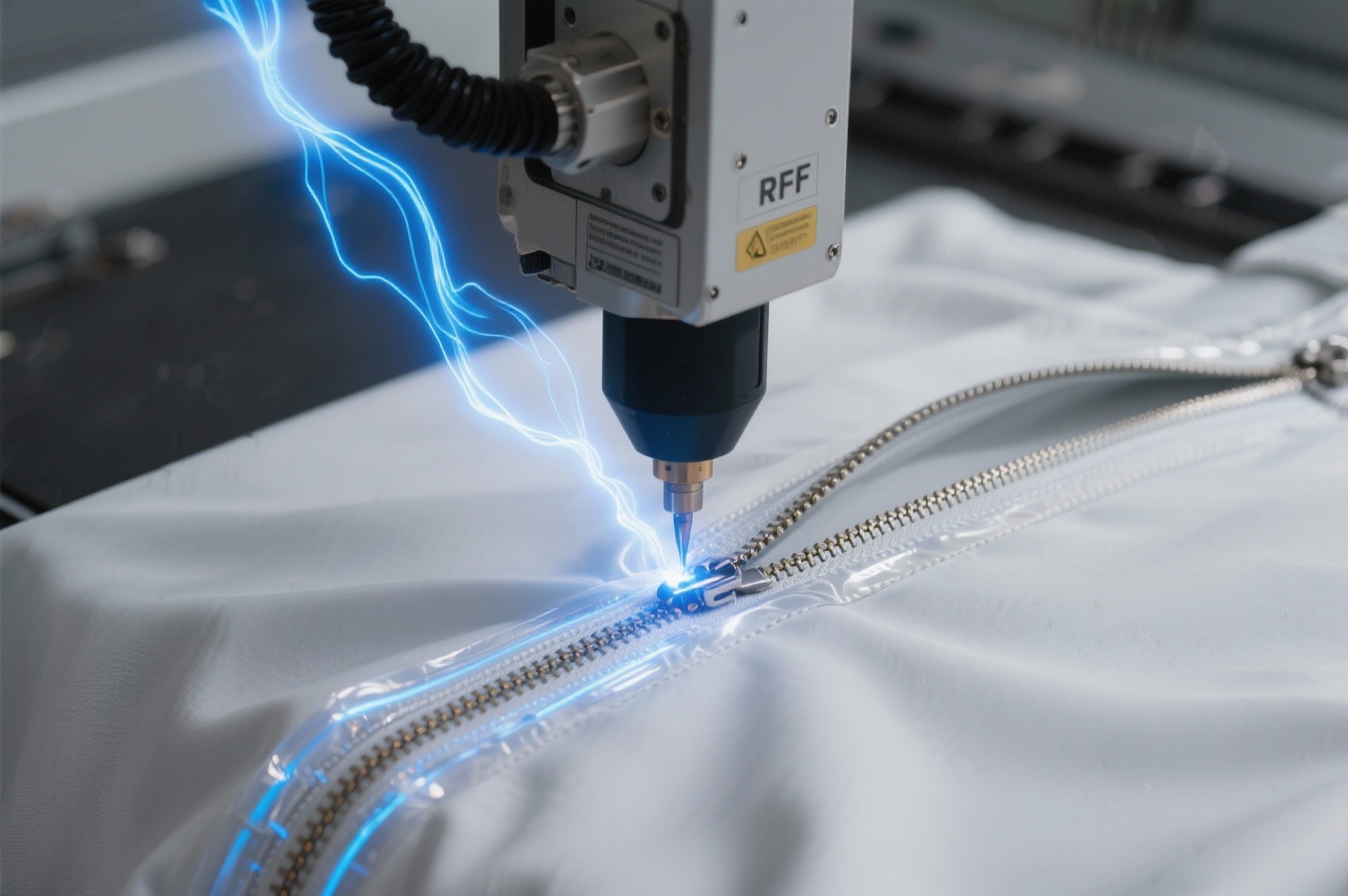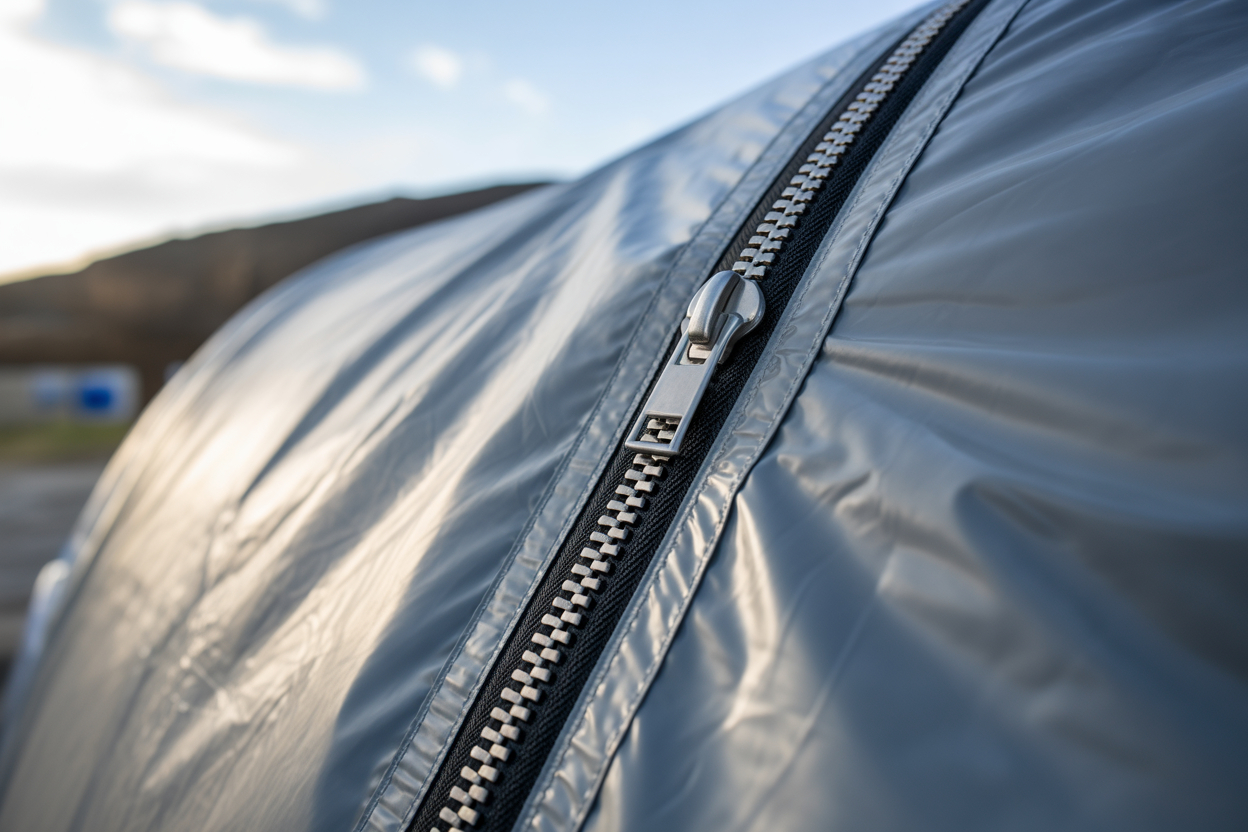In industries where even the smallest leak can compromise safety or contaminate a controlled environment, closure systems must function as pressure-bearing barriers.
From inflatable shelters and medical isolation tents to fuel bladders and environmental containment berms, reliability depends on flexible joints that hold air, gas, or liquid without leakage.
Standard zippers can’t meet these conditions — their interlocking teeth allow microscopic gaps that become measurable leaks under pressure.
LenZip bridges this gap by designing airtight and pressure-resistant zippers that combine precision mechanical engagement with polymer chemistry engineered for sealed performance.
From Water-Resistance to True Airtight Integrity
Most “waterproof” zippers are actually only water-resistant — blocking rain or splashes but still passing vapor under pressure.
A true airtight zipper must maintain a hermetic seal that prevents gas or fluid passage even when internal pressure exceeds ambient by several PSI.
LenZip achieves this by designing zipper chains and tapes as a continuous TPU-based membrane.
Each pressure-rated zipper starts with a thermoplastic polyurethane (TPU) base layer — a material whose molecular structure allows it to fuse seamlessly to coated fabrics using heat or RF-welding.
When melted, TPU flows into the fabric’s pores, bonding without adhesives or stitching — eliminating needle holes, the primary leak path in sewn seams.
The result is a smooth, flexible joint that bends without cracking while maintaining airtight performance.
Zipper teeth are molded from engineered resins that expand slightly under compression, creating a mechanical seal when the slider closes. Once locked, the chain forms a barrier capable of withstanding sustained pressure differentials.

RF Welding and Heat-Sealing: Seamless Integration
Airtight performance depends as much on installation as on component design. Conventional stitching introduces hundreds of perforations per foot of seam — each a potential leak point.
LenZip resolves this through RF welding and heat-sealable integration, a process that uses electromagnetic energy to fuse polymers at the molecular level.
During welding, the zipper’s TPU tape is sandwiched between compatible fabrics, and alternating electric fields heat the polymer from within.
This creates a uniform bond as strong as the surrounding material, preserving flexibility and eliminating the need for adhesives or mechanical fasteners.
Because TPU, PU, and certain vinyls share dielectric properties, they weld cleanly and allow easier cleaning and sterilization — critical in medical or hazmat applications.
OEM engineers can reference LenZip’s RF-Weldable & Heat-Sealable Integration Guide for detailed material compatibility and power settings.
Materials That Make Sealing Possible
The strength and reliability of an airtight zipper depend on its chemistry.
LenZip uses TPU-coated polyester tape for flexibility, abrasion resistance, and bond integrity across extreme temperature ranges.
TPU remains elastic below –20 °F and above 120 °F, ensuring consistent sealing performance in diverse environments.
For chemical-exposed applications — such as fuel containment, industrial cleaning, or medical disinfection — LenZip applies polyurethane (PU) overlays resistant to solvents, oils, and chlorine.
Tape weaves use high-tenacity polyester yarns with low wicking to prevent capillary leaks.
All metal parts, including sliders and stops, are made from zinc-free alloys or stainless steel with anti-seize and passivation treatments for smooth operation in humid or saline conditions.
Learn more about coatings and finishes through the Zipper Materials & Finishes Program.
Pressure Retention and Testing Standards
A zipper cannot be labeled airtight without verified test data.
LenZip validates every design through ASTM D7757 leak testing — the industry’s recognized standard.
Samples are installed in sealed fixtures, inflated, and monitored for pressure decay. Only zippers showing zero measurable leakage under rated PSI are approved for production.
Additional validation includes:
Burst-pressure testing
Fatigue cycling
Thermal shock (–20 °F ↔ +140 °F)
Chemical exposure simulation
Each OEM batch includes a full test report and traceability package, ensuring compliance and reliability.
See detailed testing protocols in the LenZip Testing Standards Resource.
Applications Across Critical Sectors
Inflatable Shelters & Air Structures
Emergency and military shelters must hold air pressure for days. LenZip’s TPU-sealed zippers integrate directly into inflatable frameworks, maintaining pressure even under wind or repeated entry.
Because they can be welded rather than sewn, assembly and field repair are fast — ideal for rapid-deployment operations.
Medical Containment & Isolation Enclosures
Cleanroom panels and negative-pressure tents require closures that stop viral or particulate exchange.
LenZip’s zippers withstand sterilization via alcohols, chlorine, or autoclaving up to 121 °C — all without adhesive outgassing.
For design support, LenZip offers antimicrobial zipper coatings and FDA/ISO 374 compliance guidance.
Spill Control & Environmental Containment
Oil-spill berms and chemical dikes face both hydrostatic and pneumatic stress.
LenZip’s TPU coatings resist acids, alkalis, and hydrocarbons, making them ideal for EPA-regulated cleanup operations.
See also: Chemical-Resistant Zippers for Industrial Safety.
Air Bladders & Reservoir Systems
Fuel tanks and liquid reservoirs rely on continuous pressure retention.
LenZip’s reinforced tapes maintain seal performance above 1 bar (14.5 psi) with zero leak-down, even under dynamic flexing.
Technical & Protective Apparel
Diving suits, hazmat gear, and pressurized garments use small-gauge airtight zippers for ergonomic mobility and safety.
LenZip’s hybrid TPU-coated coil designs ensure water-resistant and airtight protection in mission-critical gear.
Design Integration for OEM Engineers
Specifying a zipper for pressurized systems begins with understanding system requirements — pressure level, temperature, and chemical exposure.
LenZip collaborates directly with engineers to align zipper geometry and fabric characteristics during early development.
Because TPU and PU tapes can be welded, stitched, or clamped, integration options are broad.
LenZip provides power and dwell-time recommendations to ensure seams fuse stronger than the parent fabric.
OEMs can access CAD models, datasheets, and reinforcement guides to optimize stress distribution and serviceability.
Explore details in the RF-Weldable & Heat-Sealable Zipper Integration Guide.
Performance in Field Conditions
Real-world use subjects zippers to dust, vibration, UV exposure, and humidity.
LenZip’s TPU surfaces resist degradation and feature anti-static treatments to repel particles.
Field tests show zippers retain 95 % of tensile strength after two years of outdoor exposure and 5 000+ open-close cycles.
Consistent slider motion even in sand or ice demonstrates LenZip’s superior sealing performance.
All zippers are manufactured in Chicago, ensuring tight tolerances and full part interchangeability across OEM lines.
Maintenance and Longevity
Airtight zippers require minimal but regular maintenance.
Clean with neutral pH detergents, then lubricate with approved silicone products to preserve flexibility.
After long storage, inspect weld seams for delamination before pressurizing.
Maintenance guidelines are detailed in the LenZip Maintenance & Care Guide.
Proper care extends service life beyond 10 years — far exceeding imported alternatives.
Compliance and Quality Assurance
LenZip supplies full traceability and compliance documentation with every order — including test certificates, batch numbers, and material safety data.
All coatings meet REACH, RoHS, FDA, and EU food-contact regulations, supporting audit and validation processes.
See how LenZip ensures compliance through its Zipper Testing Standards.
Sustainability Through Durability
Long-life airtight zippers reduce environmental impact by minimizing replacements and material waste.
LenZip’s U.S.-based production reduces shipping emissions and supports ethical sourcing.
TPU and PU are recyclable thermoplastics, allowing off-cuts to be reprocessed for non-critical components.
Learn more about eco-engineered zipper sustainability and circular manufacturing initiatives.

Why OEMs Trust LenZip for Pressure-Sealed Applications
Founded in 1946, LenZip Manufacturing is among the last vertically integrated U.S. zipper producers.
All stages — extrusion, molding, coating, and assembly — occur under one roof for total quality control.
This domestic capability ensures faster prototyping, responsive engineering support, and unmatched consistency across production.
From inflatable hospital wards to oil-spill barriers in Arctic waters, LenZip’s airtight zippers prove that reliability is engineered, not luck.
Learn More
For full engineering data, seam diagrams, and validation protocols, visit the LenZip Resources Hub.
To specify RF-weldable or pressure-rated zippers for inflatables or containment systems, request a quote and collaborate directly with LenZip’s technical team.
Frequently Asked Questions
How does an airtight zipper differ from a water-resistant zipper?
A water-resistant zipper prevents temporary liquid entry; an airtight zipper maintains complete gas and liquid exclusion under sustained pressure.
LenZip’s TPU-sealed designs are tested to ASTM D7757 with zero leak-down results.
Can airtight zippers be RF-welded to any fabric?
They can be fused to fabrics coated with compatible polymers such as TPU, PU, or vinyl.
See the Integration Guide for full parameters.
What pressures can LenZip airtight zippers withstand?
Depending on configuration, most are rated above 1 bar (14.5 psi) with zero measurable leakage.
Do they resist chemicals and UV exposure?
Yes. TPU and PU coatings resist oils, solvents, and ultraviolet light, making them ideal for outdoor and containment uses.
Can these zippers be customized for OEM projects?
Absolutely. LenZip offers full customization of gauge, tape width, and coating formulation through its Request a Quote portal.
